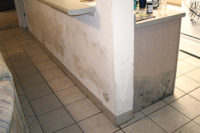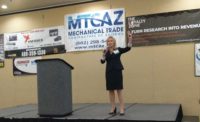These benefits include lower rates of respiratory illness, fewer dry throats and less itchy skin, and a reduction in airborne infections, not to mention benefits unrelated to health, such as preservation of woodwork and household furnishings.
As we embark on a new century, we should take a look back and recognize how far we’ve come.
An early look
In the late 1800s, families added a minimal amount of humidity to their homes through routine daily activities. Extensive food preparation, the use of teakettles, and well-watered indoor houseplants contributed to an increased level of moisture.Families also congregated primarily in the kitchen and sitting areas, so many portions of the house were rarely used during the winter to conserve fuel. Individual stoves were used to heat occupied areas.
Because moisture contributions were based only on the amount of cooking and washing done that day, it could never be referred to as high-capacity or whole-house humidification — or for that matter, even dependable. As a result, overall indoor humidification levels remained inadequate for comfort.
Indoor heating eventually progressed to the gravity furnace. These furnaces were hand-fired with a register cut into the parlor or living room floor. The furnace had a small reservoir for water, which was (or should have been) filled every week.
The heat from the furnace evaporated the water, creating a small level of moisture, but the only true benefit of this type of humidification was the self-satisfaction in thinking that something was being done about dry indoor air.
Throughout the 1930s and 40s, homes had simple plate humidifiers that required a lot of maintenance.
In the 1950s, the concept of whole-house humidification evolved with the advent of the wetted-element power humidifier. High-capacity power humidifiers were more effective than other humidification methods and required the use of a sensing device, since they were better equipped to supply adequate levels of moisture to the home.
Humidification methods
Early humidification methods used human hair as a sensor to measure and control indoor relative humidity. As the human hair element absorbed water from damp air, it expanded and sent a signal to deactivate the humidifier. During drier conditions, the sensing hair element would contract, sending a signal to activate the humidifier.Although these early systems did an adequate job of supplying moisture to the indoor air, they lacked precision and reliability. Over time, dirt and grease would build up on the hair element and decrease its sensitivity. As a result, a drift would often develop.
Drift is a change in calibration which results in an error between the actual humidity level and what the humidistat “thinks” is the actual humidity level.
Another complication for these systems involved finding suitable strands of hair. Each humidistat used approximately 150 strands of hair, none of which could be permed or color treated.
Because of these rigid standards, humidistats were expensive to manufacture. In addition, it was difficult to achieve consistency among individual humidistats.
In the 1960s, the sensing element changed from human hair to nylon ribbon, which incorporated several improvements including a cost advantage, drift improvement, and increased uniformity and consistency.
The nylon sensing element worked similar to the hair sensing element. An increase in relative humidity expanded the nylon element ribbon, which would gradually reduce the force on the switch until it opened to turn off the humidifier. A decrease in relative humidity reversed the process and closed the switch.
Not only did nylon provide lower cost and, to a certain extent, maintenance-free reliability, it could also withstand storing, shipping, and installation demands in a variety of environments — a trait lacking with the human hair sensor.
Nylon sensing humidistats were used for the next 30 years and are still used today. However, technological advancements now provide a much better way to achieve optimum indoor humidification levels.
Computerization takes over
These advancements come in the form of computer technology and, when applied to the indoor humidification process, make it possible to achieve the delicate balance between homeowner comfort and structural compatibility.Whereas nylon and hair sensing elements measure and control indoor relative humidity by expanding or contracting, a computerized humidification system uses a capacitor sensor to electronically sense relative humidity. As a result, drift is avoided and accuracy is improved.
Computerized humidifiers incorporate solid-state electronics to ensure total system reliability and precision. For instance, an automatic computerized humidifier is accurate to ±2% rh, making it up to three times more accurate and closely calibrated than manual humidification systems.
The benefit of computer technology is also apparent when comparing respective operating differentials. The operating differential is the delay between the humidifier turning on and subsequently turning off.
Every humidistat must have a slight differential to avoid the problem of constantly turning on and off.
For this reason, manufacturers of computerized systems choose to set their differential at about 3%. Because most humidistats using a hair or nylon sensing element have little or no human ability to choose an operating differential that effectively avoids drift, it may often exceed 5%.
The most advanced computerized humidification system also incorporates the use of an outdoor temperature sensor that measures and responds to changes in the actual outdoor temperature. The humidifier can immediately sense, and automatically responds to, changes in relative humidity and outdoor temperature replacing manual humidifier delays of at least a quarter hour.
Specifically, in a typical 24-hr period a computerized humidification system integrating the use of an outdoor temperature sensor can monitor the environment more than 86,000 times. Because the setpoint automatically adjusts 0.5% for every 1° change in outdoor temperature, optimum humidity can be achieved quickly and easily at all times.
Not only can a computerized humidifier provide optimum humidity levels faster than a humidistat using nylon or human hair as the sensing element, but it can also provide optimum humidity automatically, eliminating the need to make constant adjustments.
Since the introduction of the whole-house humidifier, tremendous progress has been made in the industry. Over the past 50 years, emphasis has been placed on increased comfort, convenience, and energy management.
Gone are the days of humidifiers using human hair as a sensor. Available today is an automatic humidifier using an electronic sensing device with the ability to generate more moisture and avoid condensation.





